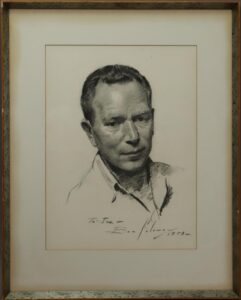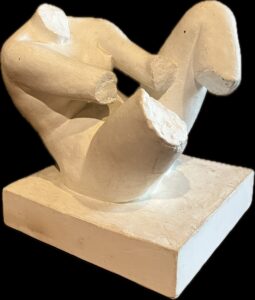Ben began experimenting with sculpture in the early 1940s. His first work was a bust of Rae made from white clay. His next pieces were small works of the human figure. He made the clay models in his studio and then had them cast in plaster using animal gelatin molds created by Philadelphia craftsman, Pietro Suffredini. Ben would then paint on the patina much like it was a canvas, building the color to get exactly what he wanted.
When Suffredini became ill and moved away from the area, Ben felt stuck. He liked what he was doing and wanted to continue, but he was unsure how to proceed. Ben was teaching at the New Hope Fine Arts Workshop at the time alongside sculptor Joe Greenberg (which is also where Joan Reiskin met Ben for the first time). Greenberg had just returned from Italy, where he spent the last four years. While abroad he had a solo show in Rome and exhibited in the XXVI Venice Biennale. In 1951 the artist was awarded a $1,000.00 prize for winning the Metropolitan Museum of Art National Sculpture Exhibition.
Greenberg had grown up in the Philadelphia area and was delighted to be working with Ben Solowey. He had looked for the big Solowey canvases in area exhibitions for years. When Ben asked Greenberg to come up to his studio to look at his sculptures and critique them, Greenberg was happy to oblige. He drove from his Buckingham home to Ben’s studio in Bedminster thinking it was quaint when painters tried their hand at sculpture and was not expecting much. When he arrived at Ben’s studio and looked at the work Ben had created—all representational figures or portraits—he was surprised. Ben kept asking how he could make his work better, and Greenberg had no answers as the work was already so accomplished.
Ben soon explained his casting situation and Greenberg informed Ben how he could make his own rubber molds. He could see how Ben had mastered so many technical requirements in renovating his home and studio, and Greenberg was confident that Ben could make his own molds. Ben’s first attempt was a disaster, and the mold refused to set. He called Greenberg in a panic, and the sculptor came to the Solowey studio and helped Ben clean up and assured Ben that the recipe for the rubber mold was finicky, and the precise amounts of ingredients had to be added at exactly the right time to avoid another problem.
Ben’s next efforts were successful, and by the late 1950s he was making clay models with his own handmade tools on a sculpture stand he made himself, as well as making rubber molds to produce plaster casts.
Among the works that Ben had sculpted and cast himself was Joyous, a relatively small piece of a seated female nude with her hands lifting one leg slightly. All the extant pieces that are documented all have a “stone” patina. The anatomical intricacy of the piece required several molds with the pieces then fused together.
We believe he later used a portion of the mold to create a new piece, Fragment that alludes to Classical Greek sculpture fragments of the human form. We don’t know how much later, and evidence suggests that he was working on Fragment in the 1970s. All the extant casts of Fragment have been left as pure white plaster, perhaps suggesting the limestones sculptures of the past.
The Reiskins acquired one of the first casts of Joyous, and this exhibition will be the first time it is shown alongside Fragment.













